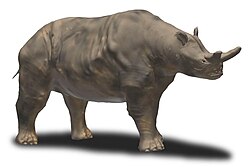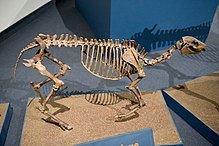White River Fauna
Fossil animals found in the western US From Wikipedia, the free encyclopedia
The White River Fauna are fossil animals found in the White River Group of South Dakota, North Dakota, Wyoming, Colorado and Nebraska in the United States. In southwest South Dakota and northwest Nebraska, these fossils are characteristic of the White River Badlands (including Badlands National Park), though they can be found far beyond the limits of the White River watershed.[1]
This article about White River Fauna includes a list of references, related reading, or external links, but its sources remain unclear because it lacks inline citations. (December 2021) |
In Wyoming, the White River Group is undifferentiated, and is more commonly known as the White River Formation. Further east in Nebraska and South Dakota, the group is divided into the Chadron Formation (lower part) and Brule Formation (upper part). Exposures are less well-investigated in northeast Colorado and scattered sites across western North Dakota. The White River Group is overlain by the Sharps Formation in Badlands National Park and the Arikaree Group in northwest Nebraska.
Animals from the White River Group date from the Eocene and Oligocene epochs. The fauna is representative of four North American Land Mammal Ages (NALMAs):
- Arikareean (late Oligocene - early Miocene, 29.5 - 18.5 million years ago)
- Whitneyan (mid-Oligocene, 31.8 - 29.5 million years ago)
- Orellan (early Oligocene, 33.9 - 31.8 million years ago)
- Chadronian (late Eocene, 37 - 33.9 million years ago)
Birds
| Genus | Species | Clade | Epoch | Image | Notes |
|---|---|---|---|---|---|
| †Bathornis |
|
†Bathornithidae | Eocene-Miocene |  |
The type genus of the Bathornithidae, large predatory birds related to seriemas.[2] |
| †Paracrax | †Bathornithidae | Closely related and similar to the conspecific Bathornis; however, it seems to have occupied more arid environments.[3] |
Mammals
Artiodactyls
Antracotheres
| Genus | Species | Clade | Epoch | Image | Notes |
|---|---|---|---|---|---|
| †Bothriodon |
|
†Anthracotheriidae |  |
||
| †Elomeryx |
|
†Anthracotheriidae |
Camelids
| Genus | Species | Clade | Epoch | Image | Notes |
|---|---|---|---|---|---|
| †Poebrotherium |
|
Camelidae |  |
Entelodonts
| Genus | Species | Clade | Epoch | Image | Notes |
|---|---|---|---|---|---|
| †Archaeotherium |
|
†Entelodontidae | Oligocene |  |
|
| †Daeodon |
|
†Entelodontidae | Miocene |  |
Leptomerycids
| Genus | Species | Clade | Epoch | Image | Notes |
|---|---|---|---|---|---|
| †Leptomeryx | †Leptomerycidae |  |
The most common fossil found in the area.[4] |
Merycoidodontids
| Genus | Species | Clade | Epoch | Image | Notes |
|---|---|---|---|---|---|
| †Eporeodon |
|
†Merycoidodontidae | Oligocene |  |
|
| †Leptauchenia | †Merycoidodontidae |  |
|||
| †Merycoidodon | †Merycoidodontidae |  |
|||
| †Miniochoerus | †Merycoidodontidae |  |
Protoceratids
| Genus | Species | Clade | Epoch | Image | Notes |
|---|---|---|---|---|---|
| †Protoceras | †Protoceratidae |  |
Ruminants
| Genus | Species | Clade | Epoch | Image | Notes |
|---|---|---|---|---|---|
| †Hypertragulus | †Hypertragulidae |  |
Creodonts
| Genus | Species | Clade | Epoch | Image | Notes |
|---|---|---|---|---|---|
| †Hyaenodon |
|
†Hyaenodontidae | Eocene - Miocene |  |
Carnivorans
Amphiconids
| Genus | Species | Clade | Epoch | Image | Notes |
|---|---|---|---|---|---|
| †Daphoenus |
|
†Amphicyonidae | Eocene-Miocene |  |
|
| †Parictis | †Amphicynodontinae |
Canids
| Genus | Species | Clade | Epoch | Image | Notes |
|---|---|---|---|---|---|
| †Archaeocyon |
|
†Borophaginae | Oligocene |  |
|
| †Osbornodon | Canidae |
Nimravids
| Genus | Species | Clade | Epoch | Image | Notes |
|---|---|---|---|---|---|
| †Dinictis |
|
†Nimravidae | Eocene-Miocene |  |
|
| †Hoplophoneus |
|
†Nimravidae | Eocene-Oligocene |  |
|
| †Nimravus | †Nimravidae |  |
Epoicotheres
| Genus | Species | Clade | Epoch | Image | Notes |
|---|---|---|---|---|---|
| †Xenocranium |
|
†Epoicotheriidae | Oligocene |  |
Lagomorphs
| Genus | Species | Clade | Epoch | Image | Notes |
|---|---|---|---|---|---|
| †Palaeolagus | Leporidae |  |
Perissodactyls
Brontotheres
| Genus | Species | Clade | Epoch | Image | Notes |
|---|---|---|---|---|---|
| †Megacerops | †Brontotheriidae | Eocene - Oligocene |  |
Equids
| Genus | Species | Clade | Epoch | Image | Notes |
|---|---|---|---|---|---|
| †Mesohippus | Equidae |  |
|||
| †Miohippus | Equidae |  |
Rhinocerotoids
Amynodonts
| Genus | Species | Clade | Epoch | Image | Notes |
|---|---|---|---|---|---|
| †Metamynodon | †Amynodontidae |  |
Hyracodontids
| Genus | Species | Clade | Epoch | Image | Notes |
|---|---|---|---|---|---|
| †Hyracodon | †Hyracodontidae | Eocene - Oligocene |  |
Rhinocerotids
| Genus | Species | Clade | Epoch | Image | Notes |
|---|---|---|---|---|---|
| †Subhyracodon | Rhinocerotidae |  |
Tapirids
| Genus | Species | Clade | Epoch | Image | Notes |
|---|---|---|---|---|---|
| †Protapirus | Tapiridae |  |
Rodents
| Genus | Species | Clade | Epoch | Image | Notes |
|---|---|---|---|---|---|
| †Agnotocastor |
|
Castoridae | Eocene-Miocene |  |
|
| †Ischyromys | †Ischyromyidae |  |
Reptiles
Summarize
Perspective
Crocodilians
| Genus | Species | NALMA | Age | Notes | Image |
|---|---|---|---|---|---|
| Alligator | †A. prenasalis | Chadronian | late Eocene | The earliest known species of alligator. |  |
Lizards
Indeterminate iguanid, skink, and diploglossine (galliwasp) fossils are also known from the White River Group.[5]
| Genus | Species | NALMA | Epoch | Notes | Image |
|---|---|---|---|---|---|
| †Aciprion | †A. formosum | Orellan | early Oligocene | An iguanian related to crotaphytids (collared lizards).[6][7] | |
| †Cremastosaurus | †C. carinicollis | Chadronian | late Eocene | A rare and enigmatic squamate based on vertebrae.[6] | |
| †"C". rhambastes | |||||
| †Cypressaurus | †C. sp. | Chadronian | late Eocene | A rare iguanid based on jaw fragments.[5] | |
| †Exostinus | †E. serratus | Orellan | early Oligocene | A rare xenosaurid known from skull fragments.[6][8] | |
| †Helodermoides | †H. tuberculatus | Chadronian to Orellan | late Eocene to early Oligocene | A glyptosaurine anguid (an armored lizard related to glass lizards and alligator lizards). Previously considered a species of Glyptosaurus.[6][9][5] |  |
| †Hyporhina | †H. antiqua | Orellan to Whitneyan | early-mid Oligocene | An amphisbaenian (worm lizard).[6] | |
| †H. tertia | Chadronian | late Eocene | |||
| †Lowesaurus | †L. matthewi | Orellan to Arikareean | Oligocene | A rare helodermatid (beaded lizard).[6] | |
| †Palaeoxantusia | †P. cf. P. borealis | Chadronian | late Eocene | A xantusiid (night lizard).[6][5] | |
| †Paraphrynosoma | †P. greeni | Orellan | early Oligocene | A rare iguanian known from a single jaw.[6] | |
| †Parophisaurus | †P. pawneensis | Orellan | early Oligocene | An anguid related to Ophisaurus (eastern glass lizards).[6] | |
| †Peltosaurus | †P. granulosus | Chadronian to Arikareean | late Eocene to late Oligocene | A common glyptosaurine anguid (an armored lizard related to glass lizards and alligator lizards).[6][9][5] |  |
| Polychrus | †P. charisticus[5] | Chadronian | late Eocene | A rare polychrotine (bush anole) based on jaw fragments.[5] | |
| Rhineura | †R. coloradoensis | Chadronian | late Eocene | A rhineurid amphisbaenian closely related to the Florida worm lizard (Rhineura floridana).[6][9][5] | |
| †R. hatcherii | Orellan to Whitneyan | early-mid Oligocene | |||
| †Saniwa | †S. edura[5] | Chadronian | late Eocene | A rare varanid based on jaw fragments.[5] | |
| †Spathorhynchus | †S. natronicus | Chadronian | late Eocene | A rare rhineurid based on a single skull.[6][5] | |
| †Tinosaurus | †T. sp. | Chadronian | late Eocene | A rare acrodontan based on jaw fragments.[5] | |
| †Tuberculacerta[5] | †T. pearsoni | Chadronian | late Eocene | A rare phrynosomatine (relative of fence lizards) based on jaw fragments.[5] |
Snakes
| Genus | Species | NALMA | Epoch | Notes | Image |
|---|---|---|---|---|---|
| †Boavus | †B. cf. occidentalis | Chadronian to Orellan | late Eocene to early Oligocene | A boine boid (true boa).[6] | |
| †Calamagras | †C. angulatus | Orellan to Arikareean | Oligocene | An erycine boid (sand boa).[6][9] | |
| †C. murivorus | Orellan | early Oligocene | |||
| †Coprophis | †C. dakotaensis | Orellan | early Oligocene | A rare booid based on eroded fossils found within a mammal coprolite.[6] | |
| †Geringophis | †G. vetus | Orellan | early Oligocene | An erycine boid (sand boa).[6][9] | |
| †Helagras | †H. orellanensis | Orellan | early Oligocene | An erycine boid (sand boa).[6] | |
| †Hibernophis[10] | †H. breithaupti | Orellan | early Oligocene | A booid based on complete skeletons.[10] | |
| †Texasophis | †T. galbreathi | Orellan | early Oligocene | A colubrid.[6] |
Turtles
Indeterminate fossils of an anosteirine carettochelyid and a ptychogastrin geoemydid are also known from the White River Group.[11]
| Genus | Species | NALMA | Epoch | Notes | Image |
|---|---|---|---|---|---|
| Apalone | †A. leucopotamica | Chadronian to Orellan | late Eocene to early Oligocene | A trionychid (softshell turtle).[11] | |
| Chrysemys | †C. antiqua | Chadronian to Whitneyan | late Eocene to mid-Oligocene | An emydid (pond turtle), sometimes known as "Trachemys" antiqua. A potential relative of modern painted turtles (Chrysemys).[11] | |
| cf. †Echmatemys | cf. †E. sp. | Chadronian | late Eocene | A "batagurid" (geoemydid) similar to Echmatemys.[11] | |
| Gopherus | †G. laticuneus | Chadronian to Whitneyan | late Eocene to mid-Oligocene | A gopher tortoise in the subgenus Oligopherus. Gopherus fossils are also known from the Whitneyan.[11] | |
| †Hesperotestudo | †H. brontops | Chadronian | late Eocene | A testudinid (tortoise). Hesperotestudo-like fossils are also known from the Whitneyan.[11] | |
| †Pseudograptemys[11] | †P. inornata | Chadronian | late Eocene | An emydid (pond turtle) closely related to Graptemys (map turtles).[11] | |
| †Stylemys | †S. amphithorax | Chadronian | late Eocene | A common testudinid (tortoise) related to gopher tortoises (Gopherus). Probably survived into the Whitneyan in the White River area.[11] |  |
| †S. nebrascensis | Chadronian to Orellan | late Eocene to early Oligocene | |||
| †Xenochelys | †X. formosa | Chadronian | late Eocene | A kinosternid (mud turtle).[11] |
Amphibians
| Genus | Species | NALMA | Epoch | Notes | Image |
|---|---|---|---|---|---|
| †Eopelobates | †E. grandis | Chadronian | late Eocene | A pelobatid frog related to Pelobates (the European spadefoot toads).[12] |
See also
Further reading
- Rachel Benton, The White River Badlands: Geology and Paleontology, Indiana University Press 2015
- William Berryman Scott, A history of land mammals in the western hemisphere, MacMillan Publishing Company, 1913
References
Wikiwand - on
Seamless Wikipedia browsing. On steroids.